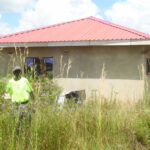A Harare family is grappling with a terrifying and inexplicable infestation of snakes, forcing them to abandon their home and sleep outdoors in fear. The Goredema family, residing at number 4791, 69 Crescent, Glen View 3, have been plagued by the persistent presence of large, brownish snakes, locally known as “madzvoti,” for the past week.
These snakes, sometimes reaching lengths exceeding two metres, are regularly found slithering under their beds, appearing seemingly out of nowhere, both during the day and as dusk settles.
The family’s two-roomed wooden house, locally known as ‘chitangwena’ surrounded by a brick wall and situated in an area devoid of nearby forests or bushes, presents a puzzle. Blessing Goredema, the 18-year-old eldest son, vividly describes the ordeal: “Since last week, we haven’t had peace at home because of these madzvoti snakes. They’re brown and can be two metres or more long. We find them under the beds, making us too afraid to stay inside, so we’re sleeping outside. Even at night, we’re too scared to sleep in the house.”
The family’s fear is compounded by the snakes’ unusual resilience. Blessing recounts a particularly unsettling experience from the past week: “Last week alone, we encountered four of these snakes on different days, managing to kill three while one escaped. These snakes don’t die, even when we hit them with metal or wood. We carry them outside after smashing their heads, only to find them still alive and changing colour as we burn them.”
The family, comprising seven members – five children, their parents, Protersia and Maxwell Nhutu – are at their wit’s end. With schools currently closed, the children, their mother, and Blessing are constantly on edge. Blessing explains the perplexing nature of the situation: “My father goes to work in the morning, and I return home in the morning too. Since schools are closed, my siblings, mother, and I are here. What’s surprising is that these snakes only appear in our house; there’s no bush nearby, and the whole house is surrounded by a brick wall.”
Neighbours report no similar occurrences, adding to the mystery. Lydia Mutemachani, Blessing’s aunt, who helped the family secure the property, shares her concerns: “I live alone here; I found this house for my relatives. This snake problem is so serious that we don’t know if it’s witchcraft or just a strange occurrence. It’s terrifying for my sister, brother-in-law, and family to continue living here. I’ve told the landlord, who lives in Chitungwiza, and he’s also wondering if there’s some witchcraft involved. Even though it’s a wooden house, where are these snakes coming from? We’re afraid they’ll eventually bite someone. The family is now sleeping outside, so we’re desperately trying to find them alternative accommodation.”
The parents, understandably distraught, are exploring all avenues for assistance. Mrs. Goredema explains their desperation: “We’re at our wit’s end with these snakes, so we’re seeking help from prophets and traditional healers because we suspect witchcraft.” Mr. Nhutu, contacted by phone, expressed similar anxieties: “Going to work has become terrifying; we don’t know what will happen while we’re away. We need help.”
The unusual nature of the situation has prompted speculation, with some attributing the problem to supernatural causes. Martha Tapfuma, known as Mbuya Shumba, a respected sangoma in Harare, offers her perspective: “This situation requires the family to be open and honest, as there’s more to this than meets the eye. There might be some unresolved issues between the parents, the use of charms, witchcraft, or family conflicts. The constant appearance of snakes suggests deeper underlying issues.”
However, a more scientific explanation is offered by Tinashe Farawo, spokesperson for the Zimbabwe Parks and Wildlife Management Authority (ZimParks). He states: “The recent heatwave has driven snakes out of their burrows, causing them to wander and inadvertently enter homes or buildings. However, harming wildlife is illegal and a serious offence.”
While this explanation addresses the increased snake activity due to the heat, it doesn’t fully account for the sheer number of snakes encountered by the Goredema family, nor their unusual behaviour and resistance to being killed.












